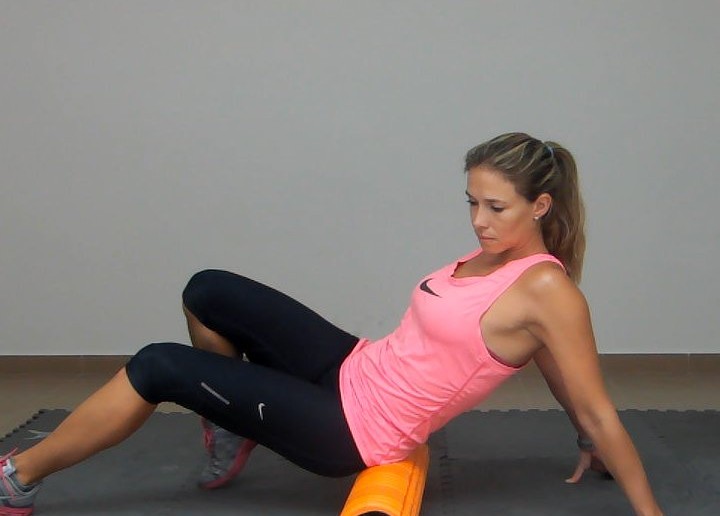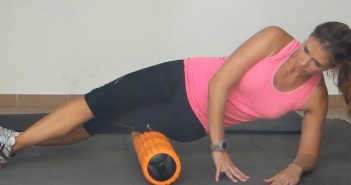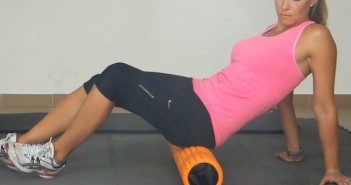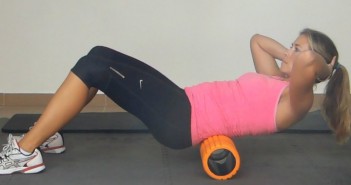Regularly using a simple and inexpensive foam roller for self-massage will improve your performance on the golf course.
When used for just a few minutes each day, from your own home, the foam roller will improve your flexibility, function, performance, and will also reduce your risk of injury.
You will reduce pain and tension, and restore normal muscle length and balance. Optimum muscle balance helps to provide optimum joint motion and control, leading to optimum performance.
Use of the foam roller is a key component in the Golf Loopy Train like a Champion System, a series of innovative and dynamic exercises and workouts that will help you to perform better on and off the golf course:
- Improve the health and quality of your muscle tissues and joints;
- Efficiently increase your stabilising strength – supporting proper body alignment, movement patterns, and energy transfer within the golf swing;
- Protect you from pain and injury by building strength and stability around your most vulnerable areas;
- Improve your mobility, balance and joint function;
- Prepare your nervous system for performing a great golf swing.
You can see the full list of foam roller exercises by visiting the Recovery & Regeneration Exercises section of the Golf Loopy Train like a Champion System.
Try it for yourself. You will be amazed!
How Does it Work?
The foam roller works by using your own body weight to massage away restrictions to normal soft-tissue extensibility.
The foam roller overloads the muscle tissues through compression, causing your nerves to relax, signalling muscle spasms to shut off, pumping blood and and getting your lymphatic system flowing, to help muscle recovery and regeneration.
You’ll work out those knots (muscle adhesions) in your muscles caused either by inactivity, by the repetitive strain of the golf swing, or by walking a tough golf course. This will enable you to stretch the muscles back out to their original length, making them more pliable and functional.
How Does it Improve Performance?
The kinetic chain that powers your golf swing is made up of the soft tissue system (muscles, tendons, ligaments, and fascia), the neural system (nerves and your central nervous system), and the articular system (joints).
All of the components of the kinetic chain are interdependent. If one segment is not functioning efficiently, then the other components must compensate, leading to tissue overload, fatigue, faulty movement patterns, and potential injury.
Muscle tightness restricts the range of motion that a joint may be moved. Because of muscle restriction (tightness, soft tissue adhesions, and neural-hyperactivity), joint motion is altered, thus altering the normal neural feedback to the central nervous system. Ultimately, neuromuscular efficiency is compromised , which leads to poor movement patterns, inducing premature fatigue and causing injury.
The foam roller helps you to improve muscular balance and performance, thus helping to avoid the poor movement patterns that arise from muscle tightness.
The bottom line: the foam roller will make you a better golfer.
The foam roller will:
- Correct muscle imbalances;
- Improve the range of motion in your joints;
- Relieve muscle soreness and joint stress;
- Decrease the tension in the muscles that impairs proper movement (neuromuscular hypertonicity);
- Increase the extensibility of the connections between your muscles and their tendons (musculotendinous junctions);
- Improve the ability of your nervous system to properly control your muscles (neuromuscular efficiency);
- Maintain normal functional muscular length.
How to Use a Foam Roller
Using the foam roller for deep tissue massage is easy if you follow the instructions given in the golf-specific recovery and regeneration exercises in the Golf Loopy Train like a Champion System.
Just as with a professional sports massage, you will be able to work out the knots in your muscles. This process may be uncomfortable and at times painful.
To foam roll properly, apply moderate pressure to a specific muscle or muscle group using the roller and your bodyweight.
Never roll a joint or bone.
You should roll slowly, and when you find areas that are tight or painful, pause for several seconds and relax as much as possible. You should slowly start to feel the muscle releasing, and after 5-30 seconds the discomfort or pain should lessen.
If an area is too painful to apply direct pressure, shift the roller and apply pressure on the surrounding area and gradually work to loosen the entire area.
The goal is to restore healthy muscles – it is not a pain tolerance test!
You can use the foam roller to great benefit both before and after playing golf, practising on the range, or other physical activity. It’s also great after sitting in the same position for a while, and can be enjoyed anywhere and anytime you feel tight and in need of a massage, such as while watching television or before bedtime.
Choosing a Foam Roller
When choosing a foam roll, its density is very important. If the foam is too soft, it won’t massage your tissues effectively. If the foam is too hard, bruising and more advanced soft-tissue trauma may occur, leading to further restriction, inflammation, decreased range of motion, pain, and decreased performance.
If you have any questions or comments about this or other articles on Golf Loopy, please send us an email.
You May Also Like…
Golf Performance Programmes – the most effective golf-specific fitness regimens on the planet, guaranteed to make you a better golfer!
There are a number of other golf-specific recovery and regeneration exercises in the Golf Loopy Train like a Champion System.
The Golf Loopy Perfect Warm Up, an exercise routine that has been scientifically designed to prepare your mind and body for playing golf to the best of your ability in just 7 minutes.
Introduction to the Swing like a Champion System.
Golf Anatomy and Kinesiology, a collection of articles describing the roles of the muscles involved in the golf swing.




